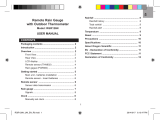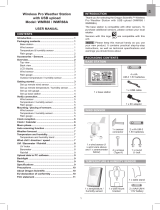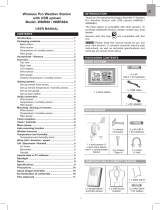
UNPACK
Make sure that you have all of the parts of one of the three
groups of products shown here before the installation of your
Weather Collection product.
A
SET-UP WIRELESS SENSOR
B
SET-UP MAIN UNIT
C
WEATHER
THN132N
Temperature
Sensor
1×
RAIN AND
TEMPERATURE STATION
Rain Collector
1×
Screws (Type C)
3×
Washers
6×
Filter
1×
Main Unit
1×
QUICK START GUIDE
OREGON SCIENTIFIC WEATHER COLLECTION
Slide open battery door
1
Install the battery, matching polarity (+/-)
2
Assign a channel by sliding selection switch to the appropriate
channel (1,2,3) location. If installing additional sensors, make
sure you assign a different channel for each sensor.
Press the reset button
Before placing the sensor outdoors, please verify
communication with the main unit by placing the sensor next to
the base unit during this setup process.
3
4
Atomic Clock Signal
Atomic clock synchronization will automatically occur after
installing the batteries. Reception takes 2-10 minutes. If the
signal is weak, it can take up to 24 hours to retrieve a valid
signal.
Please monitor atomic clock icon ( ) on the bottom part of the
LCD display next to the time. This icon indicates the status of
the clock reception signal.
3
WEATHER
THGR122NR
Temperature/
Humidity Sensor
1×
Main Unit
1×
Main Unit
1×
2
1
3
4
Install the required number of batteries in the battery
compartment located on the back of each main unit.
1
There are two types of signals the main unit will receive:
Temperature Signal
After installing the batteries, the main unit will automatically
search for the signal from the wireless sensor. Once a
temperature reading is displayed on the LCD screen,
communication is now established.
2
1
2
3
Time is synchronized.
Receiving signal is strong.
Time is not synchronized.
Receiving signal is weak.
: BAR206A
: BAR208HGA
RAIN AND TEMPERATURE STATION:
RGR202A
: EMR201A
: RMR202A
: RMR203HGA
You will have one of the following Oregon Scientific products:
100
200
300
500
100-400
400
500
*
*
THN132N
Temperature
Sensor
1×

SET-UP RAIN GAUGE
D
PLACE WIRELESS
SENSOR OUTSIDE
E
Contact our Customer Service Department for additional questions:
website: www2.oregonscientific.com/service phone: 800.853.8883 (voice) address: 19861 SW 95th Avenue, Tualatin, OR 97062
Tilt the tipping funnel on the rain gauge several times and verify a numerical
reading on the base unit ( ). Numerical reading will take approximately
30-45 seconds to transmit to the main unit.
Press and hold the SINCE button for two seconds. The total rainfall and today
rainfall will be reset to zero.
Secure the battery cover with eight screws.
6
7
8
After verifying connection to the base station, place the rain gauge outside on
a level surface and place a few drops of water on the cross at the base of the
funnel to check the horizontal level. Water will pool to the center of the cross
when the rain gauge is level. You can adjust the level when securing the rain
gauge on the level screws by using the mounting screws.
To complete the installation, slide the hood cover on and secure with two base
screws located on the bottom rim of the rain gauge. Place the filter in the cup
to prevent leaves or other debris from blocking water from entering the cup.
9
10
Remove the two base screws located on the bottom rim of the rain gauge
and slide the hood cover off to expose the battery compartment.
Locate the battery compartment and remove the eight screws that secure the
cover. Install two AA batteries.
Remove the packing tape from the tipping funnel.
1
2
3
Press the RESET button.
Press the SEARCH button on the main unit to initiate a wireless sensor search.
Before proceeding to install the rain gauge outside, please verify
communication to the main base station.
5
4
1
3
2
6
8
10
9
4
FOR THE RAIN AND TEMPERATURE STATION
5
7
2
*
Find a location for the temperature and humidity sensor
Temperature and thermo-humidity sensors should be located in areas
protected from the sunlight and rain. Mount the sensor under a covered
location like a roof overhang or under the eaves. This will ensure accurate
temperature and humidity readings.
1
Find a location for the wireless rain gauge
The wireless rain gauge should be placed on a flat and level surface. The
location must be away from anything that may block rainfall from entering the
rain collector. Rain gauge should be elevated off the ground. Placing your rain
gauge on your outside deck would be an ideal location.
The distance between the main unit and remote sensor should not be greater
than 100 feet.
2
*
FAQ’s (Frequently Asked Questions)
Problem Applicable Models Solutions
"--.-" appears on the
temperature display
Weather forecast icons is
displaying the wrong forecast
"--%" appears on the remote
humidity display
Outdoor temperature
reading is wrong.
When does the memory
reset
Weather warning display
is blank
Atomic Clock is not
syncronizing
All models
BAR208HGA, BAR206A
BAR208HGA, BAR206A,
RMR203HGA
All models
BAR208HGA, BAR206A,
RMR203HGA, RMR202A
BAR208HGA
BAR208HGA, BAR206A,
RMR203HGA, RMR202A
1) Check main unit or remote sensor battery levels by viewing the appropriate icons on main unit display.
2) Place the main unit away from other electronic devices that might cause signal interference.
3) Decrease the distance between the remote sensor and the main unit
The weather forecast feature does not show you current conditions outside, rather it will forecast what the
weather will be in the next 12+ hours. Weather forecast is calculated to be 75% accurate
NOTE: If you have the RMR203HGA, you need to purchase the THGR268 sensor to display outside humidity.
1) Check main unit or remote sensor battery levels by viewing the appropriate icons on main unit display.
2) Place the main unit away from other electronic devices that might cause signal interference.
3) Decrease the distance between the remote sensor and the main unit
Move the remote sensor to a location that will not expose it to direct sunlight or rain.
Min/Max memory resets at 12:00 am everyday.
The Weather Warnings icons will activate when current weather conditions fall under specific temperature,
barometric, or humidity requirements.
"Move the main unit close to a window, away from other electronic devices, and hit the up button to intitiate
an atomic clock signal search. The best time to achieve successful signal synchronizing is during nighttime
hours. It can take up to 24 hours to receive a signal.”
1
-
 1
1
-
 2
2
Oregon BAR208HGA User manual
- Category
- Weather stations
- Type
- User manual
Ask a question and I''ll find the answer in the document
Finding information in a document is now easier with AI
Related papers
Other documents
-
 Oregon Scientific RGR126N User manual
Oregon Scientific RGR126N User manual
-
Oregon Scientific BAR208HGA User manual
-
Oregon Scientific BAR208HGA User manual
-
Oregon Scientific BAR208S User manual
-
 Oregon Scientific P-ATC9KG Datasheet
Oregon Scientific P-ATC9KG Datasheet
-
 Oregon Scientific WMR88A User manual
Oregon Scientific WMR88A User manual
-
 Oregon Scientific WMR88 User manual
Oregon Scientific WMR88 User manual
-
Oregon Scientific WMR86 User manual
-
IDT Technology NMTWMR180-01 User manual
-
Oregon Scientific WMR100A User manual





